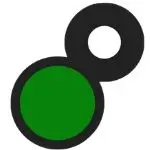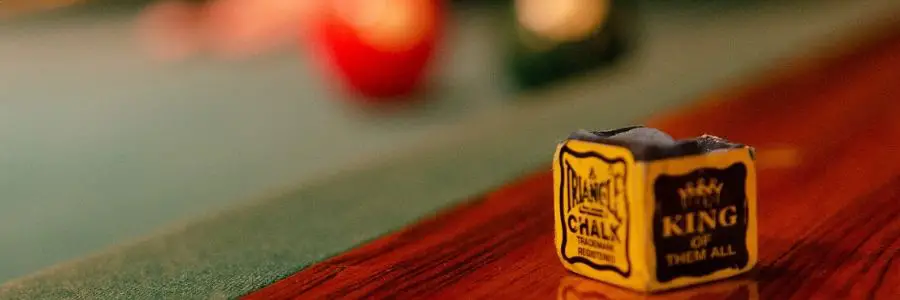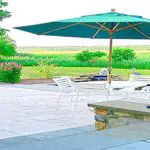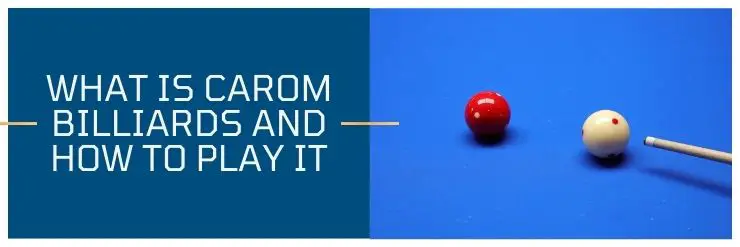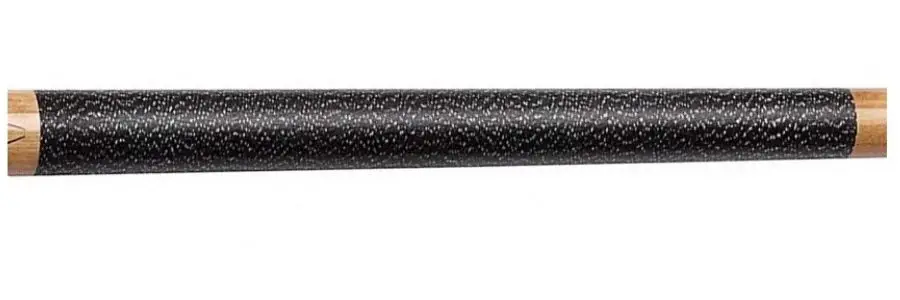There are many aspects to this beautiful game that may surprise you but there is a subtle but significant tool in your cue sports arsenal that mustn’t be underestimated so you can sink that remarkable shot – The mighty pool chalk!
Learn how to chalk a pool cue correctly as this will greatly improve your shots.
Apply your chalk firmly, gently and fully. Cover the tip completely in chalk but don’t be too rough with your cube of chalk. Follow pool table etiquette and don’t get the chalk wet.
Knowing how to chalk a pool cue properly is not too difficult and will help you avoid annoying miscues that happen from time to time, especially if you don’t chalk at all.
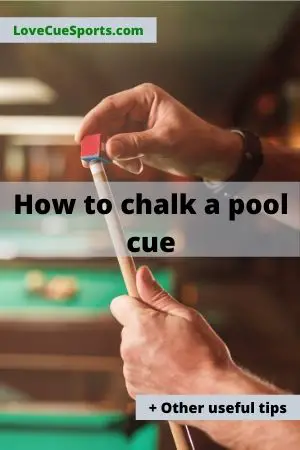
Believe it or not but there are ways you shouldn’t chalk your cue and types of chalk you should and shouldn’t use, keep reading and we will discuss them all here.
How to Chalk a Pool Cue
Knowing how to properly chalk a pool cue as you is simple to learn but provides maximum value. Chalk your stick like you do a lipstick. Do it gently, lightly but evenly, and completely. Do not drill the cube into the tip! Stroke the chalk over the curve of the cue tip, gently but firmly.
Learning how to chalk a pool cue will be something you will implement for the rest of your life. this small yet fundamental bit of information will become the cornerstone of your game and success.
Knowing how to chalk a pool cue will help the cue grip better to the cue ball, especially when applying English.
That extra grip will help mitigate any miscues that might have happened if you hadn’t of chalked your cue.
A few things to consider is that if you have softer chalk, you will need more chalk than you may think.
As a consequence, your billiards hand chalk will not last as long and you will need to re-purchase.
The harder ones may be the better option if this bothers you.
I wrote an article on my best pool cue chalk, if you are in the market for some great chalk to enhance your game, then I highly recommend you check them out.
How to chalk a new pool cue
If you have just purchased a new tip or a new cue and are wondering how to chalk a new pool cue or tip, then ill walk you through the process.
Chalking a new pool cue tip is very similar to how to chalk a cue regardless of whether it’s new or not; simply stroke the chalk over the tip fully coating the tip in an even layer of chalk.
That being said, some new cue tips will need to be shaped and roughed up a little to create a suitable surface for chalk to adhere to.
If you are finding your new pool cue tip is not holding chalk well you can use a tip tool, similar to the Cuetec Bowtie (Check out on Amazon) and scuff the tip, creating a rough tip surface that will hold chalk much better.
How to chalk a pool cue properly
- Take your chalk cube and “stroke” 6 or 7 times on the tip.
- Be sure to “stroke” the edges and the top of the tip to fully cover it evenly in chalk.
- Evenly coat the chalk over the whole of the tip
Remember to replace your chalk when needed, don’t just leave it till there are just the scraps left.
Check out the “Do’s” and “Don’ts” of chalking a cue below
DO
- Using the edge of the chalk to “stroke” it on.
- Apply the chalk evenly over the whole tip, ensuring its covered completely.
- Gently but firmly is the key here.
- Ensure edges of the tip are covered – this adds extra grip for spin shots!
DON’T
- Place the chalk cube on top of the cue tip and rotate the cue into the chalk.
- Apply the chalk to roughly.
- Blow the the excess chalk off the tip
Learn More…
You have learned how to chalk a pool cue, now learn why we chalk our pool cues? Check out how long they last and learn how to keep them in better condition for longer!
How often should i chalk my pool cue
How often should you chalk your cue is a personal preference, most prefer to chalk after every hit, others after a few hits. Some chalks, like magic chalk, will retain itself well on the tip while others like Silver cup chalk wont last as long. Most people will chalk after every shot.
You might be curious about how often should you chalk your pool cue.
Its really a matter of preference, but myself and a lot of other people will chalk more or less after every shot.
That’s not to say billiards hand chalk is required after every shot, but that’s the habit I am in.
How often you should chalk will depend on a few factors, what chalk you are using, how hard you hit the ball, the type of shot you are playing.
If you are looking to play a shot that requires extra cue ball spin then applying chalk will help with that type of shot.
All chalks do the same job, help add friction to the cue ball. The difference between chalk brands is minimal and therefore doesn’t always warrant spending huge amounts on cubes of chalk.
Where the different chalk brands differ is how long chalk is retained on the cue.
As I chalk up after most shots this doesn’t really affect me but its interesting to know.
A study on different chalk brands revealed the average amount of shots before a miscue occurred.
| Chalk Brand | Shots before miscue |
| Silver Cup | 7 |
| Masters | 8 |
| pre-flag | 8 |
| Lava | 9 |
| Blue Diamond | 11 |
| Kamui | 15 |
| Magic Chalk | 29 |
Hot Tip – Rough It up a Little
I don’t know if you have noticed but the cue ball doesn’t have any flat surface … shock , i know!
Your leather cue tip will not be able to grip to that round surface as easily as could if you apply some chalk.
You need the added friction to prevent embarrassing miscues. But what happens if you feel your not getting the desired grip on the cue ball even tho you have chalked?
Perhaps the culprit is the tip of your cue, after some time the tip will become compact after countless strikes against the white ball leaving the tip smooth.
Chalk will have a hard time sticking to a smooth tip meaning you now have a valid excuse for all them bad shots!
Time to rectify – using a simple tip tool such as Cuetec Bowtie (Check out on Amazon) tip tool you can rough up your tip a little.
Using the tool to scuff the surface of your tip allows chalk to stick much easier which will give you the grip you need to make that crucial draw shot.
What are the benefits of Chalking
There are many benefits to chalking your cue. Chalking your cue can help you better control your cue ball, improve your aim, and make it easier to hit your targets. It is recommended that you chalk your cue before every shot. This will help ensure that you have the best possible chance of making your shot.
Knowing how to chalk a cue isnt enough, lets understand what the benefits are.
We just said that chalking gives the added friction that prevents the cue tip from slipping right off the ball’s spherical surface. Thus, this practice mitigates miscue.
But is thee anything else it can help with?
If you apply the right amount of pool chalk, you will find it much easier than ever to do the following important things:
- Hit below the center of the cue ball to insert back the spin (draw)
- Apply left and right english to the ball
- Hit above center on the ball to put forward spin on the cue ball
- Execute powerful shots
What shouldn’t You do when chalking a cue
Never Chalk Over the Table
If you fail to follow this basic principle, you will get lots of billiard chalk dust and chips on your cloth.
In the end, you will most likely make the cloth and your cue balls dirty, which can cause them to start responding unpredictably.
It is possible to clean the excess chalk from the felt, but it’s always best to avoid chalking over the cloth to start with.
Don’t Blow the Excess Chalk Dust
Since you are not supposed to bang your cue stick against anything, not even your table, you have no way to remove the dust.
If you are thinking that you can blow on your pool tip to remove the extra chalk then I’m sorry to tell you but that’s a no-no. If you try this, the moisture from your breath will more than likely make your chalk become clotted having a negative effect on your shots.
If you do need to remove some of the excesses then I suggest you gently tap your cue away from the pool table.
Never Force Your Cue into the Chalk
I advise that you avoid drilling any hole in your chalk as well since that fine chalk powder will get everywhere.
You’ve learned how to chalk a pool cue, so you know this isn’t the correct way,
Unless the correct way is ruining a good cube of chalk and getting chalk dust everywhere.
Never Set the Chalk Color Down on the Table
What I mean here is that you should not set your chalk down with the chalk facing down.
This is one of the best ways to ensure your table, your clothes, your hand, and your balls and equipment remains clean.
Chalk has a nasty habit of getting everywhere – avoid it as best you can
What kind of chalk do pro pool players use
Each player will have a different preference when it comes to pool chalk but a common chalk professionals like to use is Kamui Chalk (Amazon link).
This chalk is made with a stickier compound which allows for a better grip on the cue ball.
The chalk needs to be applied in a thin layer to the tip of your pool cue. Be sure not to apply too much or it will make it difficult to shoot.
You can check out my list of fantastic cue chalks that i recommend here.
Does pool chalk color matter when playing pool
The color of your pool chalk wont affect your game but it may leave visible marks on your pool table felt. If you chalk your pool cue with blue chalk but your pool table colth is green , the marks will be noticeable.
This is why its recommended to play with chalk that is the same color as your pool table felt.
Can you play pool without chalk
It is possible to play pool without chalk but you will likely have a harder time gripping the cue ball. Chalk helps the friction between your cue and the ball, so if you don’t use it, your shot may not grip correctly, resulting in a misscue.
No matter what kind of chalk you decide to use, be sure to practice with it so you can get a feel for how it affects your game. Everyone plays a little differently and you may need to adjust your shots when using
Pool chalk can help improve your game by giving you a better grip on the cue ball.
Conclusion
We looked at how to chalk a pool cue properly as well and many other related questions.
I hope you remember your success as a billiard player depends on many factors, learning how to properly chalk a pool cue is just one factor.
That little blue cue of chalk if there for your benefit, use it consistently and you shouldn’t have to worry about miscueing.
Rob is an avid player and fan of all cue sports, particularly 8-ball, and snooker. He has competed in a few local 8-ball tournaments and although he is not a professional, he can compete with the best of them.
